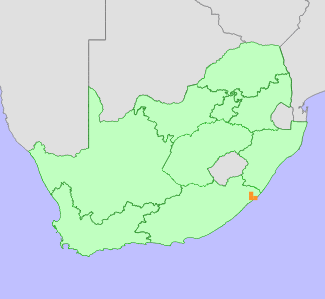|
Scientific Name | Aristea platycaulis Baker |
Higher Classification | Monocotyledons |
Family | IRIDACEAE |
National Status |
Status and Criteria | Vulnerable D2 |
Assessment Date | 2021/03/01 |
Assessor(s) | L. von Staden, J.E. Victor & C.R. Scott-Shaw |
Justification | This range-restricted species, with an extent of occurrence (EOO) of 200 km², is known from very few records. The forest margin habitat (area of occupancy estimated to be less than 15 km²) is affected by invasive alien species and degradation due to wood collection, which could potentially threaten this species. This species is therefore listed as Vulnerable under criterion D2. |
Distribution |
Endemism | South African endemic |
Provincial distribution | Eastern Cape |
Range | This narrow endemic from the Eastern Cape province, is known only from the Pondoland coast between Port St Johns and Port Edward. |
Habitat and Ecology |
Major system | Terrestrial |
Major habitats | Scarp Forest |
Description | It occurs in forest margins of coastal forests in partly to fully shaded sites. |
Threats |
| Invasive aliens such as Chromolaena odorata, Solanum mauritianum and Lantana camara have infested most forest areas on the Wild Coast (Mucina and Rutherford 2006), even in some very inaccessible areas as these plants are dispersed by birds. These alien invasives are particularly affecting forest margins, the habitat of this species, where they thrive in the semi-shaded conditions. It is not known whether alien invasives negatively affect this species, but it is a serious potential threat that requires monitoring of subpopulations to determine whether or not it is causing an ongoing decline.
Due to the breakdown of traditional authorities in the Eastern Cape, many forested areas, even in reserves, have become very degraded due to overexploitation of forests for firewood harvesting and bark stripping for muthi that leads to the death of mature trees (Mucina and Rutherford 2006). This could potentially impact this species across the range. |
Population |
Population trend | Stable |
Conservation |
| It is conserved in Mkambati Nature Reserve. |
Assessment History |
Taxon assessed |
Status and Criteria |
Citation/Red List version | | Aristea platycaulis Baker | VU D2 | Raimondo et al. (2009) | | Aristea platycaulis Baker | VU D2 | Scott-Shaw (1999) | | Aristea platycaulis Baker | Vulnerable | Hilton-Taylor (1996) | |
Bibliography |
Goldblatt, P. and Manning, J.C. 2020. Iridaceae of southern Africa. Strelitzia 42. South African National Biodiversity Institute, Pretoria.
Hilton-Taylor, C. 1996. Red data list of southern African plants. Strelitzia 4. South African National Botanical Institute, Pretoria.
Mucina, L. and Rutherford, M.C. (eds). 2006. The vegetation of South Africa, Lesotho and Swaziland. Strelitzia 19. South African National Biodiversity Institute, Pretoria.
Raimondo, D., von Staden, L., Foden, W., Victor, J.E., Helme, N.A., Turner, R.C., Kamundi, D.A. and Manyama, P.A. 2009. Red List of South African Plants. Strelitzia 25. South African National Biodiversity Institute, Pretoria.
Scott-Shaw, C.R. 1999. Rare and threatened plants of KwaZulu-Natal and neighbouring regions. KwaZulu-Natal Nature Conservation Service, Pietermaritzburg.
Vincent, L.P.D. 1985. A partial revision of the genus Aristea (Iridaceae) in South Africa, Swaziland, Lesotho, Transkei and Ciskei. South African Journal of Botany 51(4):209-252.
|
Citation |
| von Staden, L., Victor, J.E. & Scott-Shaw, C.R. 2021. Aristea platycaulis Baker. National Assessment: Red List of South African Plants version 2024.1. Accessed on 2025/10/26 |
 Comment on this assessment
Comment on this assessment


